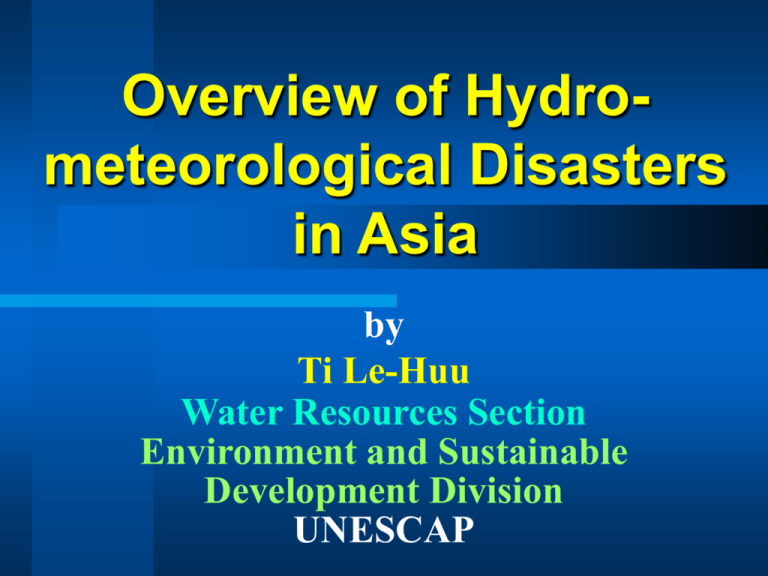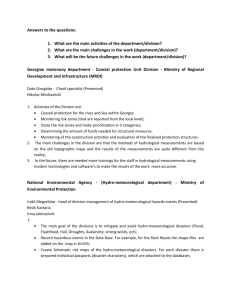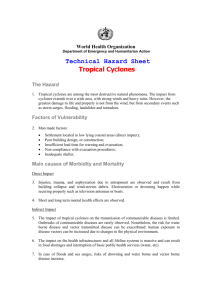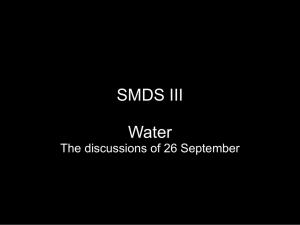Overview of Hydro-meteorological Disasters in Asia by Ti Le
advertisement

Overview of Hydrometeorological Disasters in Asia by Ti Le-Huu Water Resources Section Environment and Sustainable Development Division UNESCAP Main Points of Discussion Natural hazards and hydro-meteorological disasters Hydro-meteorological disasters in Asia Recent developments in dealing with hydro-meteorological disasters Trends in disaster management in national planning Needs and recommended priority actions Major Hazards in Asia Floods Cyclones Earthquakes Droughts Tornadoes Debris flows Hailstorms Storm surges Tsunamis Haze Source: UNESCAP Surveys Hydro-meteorological Disasters in the Region Asia is one of the most vulnerable regions of the world to water-related natural disasters, including floods, cyclones, droughts, tornados, debris flows, hailstorms and storm surges (ESCAP’s recent surveys). All countries in Asia are affected by annual hydro-meteorological disasters. Characteristics of hydro-meteorological disasters may vary among the countries. Floods in hydrometeorological disasters The most frequent and severe natural disaster in Asia is floods. Critical years: 1992 to 2003. Most severe years: 1998, 2000, 1997 and 1995. During the last Decade, floods caused nearly 200,000 deaths and damage of several tens of US$ billions (including US$23 billion lost in 1998 mostly by floods in China, RoK and Viet Nam) Annual Impacts of Hydrometeorological Disasters Order of impacts: floods, strong winds, land slides, storm surges. Annual damage by hydrometeorological disasters in the typhoon area varies from $5.5 million in Hong Kong, China to $1.96 billion in Japan. Benefits from typhoons: 50% of annual rainfall in Philippines. A recent flood in Cambodia A recent flood in Moosan City, Republic of Korea Perspectives Hydro-meteorological disaster management has a long history of mankind. Achievements are different from one country to another depending on socio-economic conditions. Diversity in the region provide a wide spectrum of achievements in hydrometeorological disaster management processes. In India, recent trends are decreasing. In Thailand, overall trends are increasing, except recent damage trend In Philippines, all trends are increasing, except recent house damage In Japan and ROK, decreasing trends of disasters impact are obvious, although it is much clearer in the case of Japan Best Regional Practices Cyclone and Flood EWS: Typhoon Committee, Panel on Tropical Cyclones, Mekong River Commission and several countries in the region Community-based disaster management: Typhoon Committee, DPR-SEA-2 and ADPC-IFRC Workshop on Disaster Management Practitioners Key Messages Hydro-meteorological disasters continue to be one of the most important impediments to sustainable socioeconomic development and poverty eradication in Asia Success in hydro-meteorological disaster management depends on how effective the activities are integrated into the national development process Effectiveness of the integration depends correct understanding of socio-economic impact of the disasters at all levels: regional, national, sub-national and local Opportunities Preparatory activities of the World Conference on Disaster Reduction in Kobe, Hyogo in January 2005 Importance of hydro-meteorological disaster management in formulation of IWRM and WSSD targets on IWRM Plan in 2005 Importance of disaster management in poverty eradication of MDGs and JPOI Recommended Priority Actions Search for appropriate methodologies to assess socio-economic impact of disasters Undertake pilot projects on application of these methodologies to better support the national development processes Propose strategies for disaster impact assessment in the region, based on experiences of the pilot projects and best regional practices Develop a regional programme on management of hydro-meteorological disasters for poverty eradication to be presented at the World Conference on Disaster Reduction in 2005





